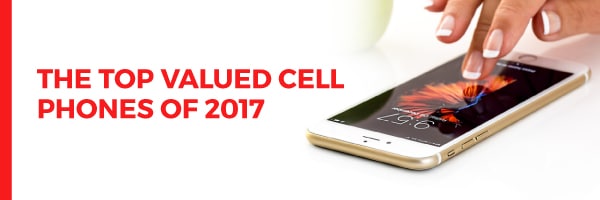
If you’re like most smartphone owners, you’ve likely traded in a smartphone for the next model. You get rid of an old phone you won’t use anymore and use it to finance your next device purchase. If you trade in your devices often, however, you may have noticed that some of your devices are worth more trade-in credit than others. What determines the highest resale value in cell phones? Read this guide to discover the factors at play in determining cell phone value and learn which phones have the highest resale value in 2017.
How Do You Judge a Phone’s Value?
With mobile technology developing so quickly, we expect the new big thing in the smartphone world each year. With ever-improving features and functionality, each new model is more interesting than the last, making it more tempting to trade in your old model. While this quick technological turnaround keeps the secondhand phone market booming, it also means phones lose their value more quickly than some other consumer items.
Quick devaluation means choosing the right phone could save you considerable money during your next trade, but making the right choice takes time because some phones depreciate more quickly than others. You’ll need to educate yourself on the factors impacting your smart phone’s resale value.
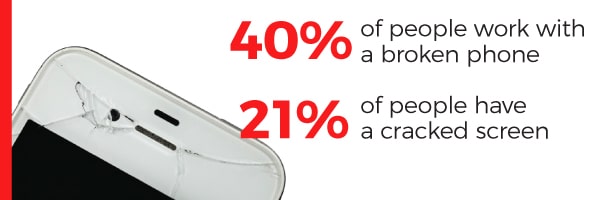
The big factors contributing to a phone’s resale value include:
- Brand: One of the biggest contributors to a phone’s resale value is the phone brand. Currently, the two big names in the smartphone industry are Apple with the beloved iPhone and Samsung with the popular Galaxy line. Brands outside of these two may start at similar prices but tend to decline more quickly than either brand due to a lack of name recognition.
- Original Price: High-end smartphones tend to show their age more quickly than the lower-end varieties, with their prices falling more quickly in the months following their release. Though the price decline tends to even out over time, lower-end smartphones like the Google Nexus and Motorola G4 tend to hold their value for longer.
- Phone Damage: If you’re one of the 40 percent of people working with a broken phone or one of the 21 percent of people with a cracked screen, you’re going to receive less than full value out of your next trade. If the phone is a newer high-end model of a popular brand, you’re more likely to receive a decent amount of cash for it. Most resellers will repair and refurbish pricey models to cash in on the thriving secondhand market.
- Accessories and Features: While special features and built-in accessories may seem like a good idea at the time of purchase, they tend to lose their value the quickest. Unique features are disproportionately marked up and hyped to make a bit of extra cash, but it does little for the phone’s long-term value.
- Customizability: Custom phones, though popular, tend to retain value poorly. This is primarily because no two people have the same tastes and preferences, and many people lose interest in customized accessories for secondhand phones. Additionally, specialty phone skins and monogrammed details tend to come in and out of fashion, contributing to a phone’s depreciation even more.
- Time: The big equalizer and the most important factor in the resale price of a phone is time. For the majority of smartphones, the price of the phone will decrease to 40 percent or lower after 6 months, and 20 percent or lower after a year and a half. Large name brands like the Samsung Galaxy and Apple iPhone will continue to retain about 20 percent of their value after as much as two years.
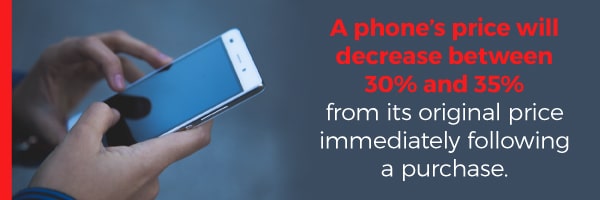
All of these factors contribute to the total depreciation of a smartphone over time. The best way to see this in action is to look at the price drops by percentage each month after a phone’s release. On average, a phone’s price will decrease between 30 and 35 percent from its original price immediately following a purchase. After that, most smartphones continue to depreciate at a rate of 4 to 5 percent each month. After 6 months, most phones depreciate to around 35 percent of their original price, though the speed at which they depreciate varies based on the factors discussed above.
Which Phone Brands Retain Value?
When you’re talking about which factors contribute to the highest trade in values for cell phones, it’s important to distinguish brand above all other price factors. Samsung and Apple brand prices tend to behave differently than others within the market. Whereas most smartphones see very similar price declines after six months, both the Samsung Galaxy and the Apple iPhone retain their value for a year or more. For this reason, users of brands like LG and HTC will likely not need to worry too much about their smartphone choices after a year, whereas Samsung and iPhone users will need to pick the best models to get the best trade in value. Below, we’ll take a look at how the phone values of some of the top brands have performed historically to predict which phones will be retain the most value this year.
Apple Phones
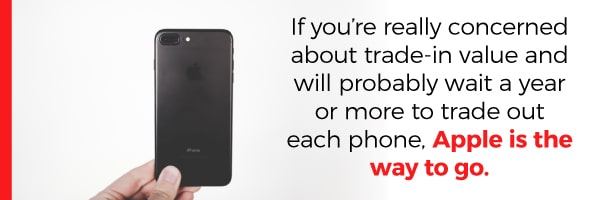
The bottom line with Apple iPhones is this: If you’re really concerned about trade-in value and will probably wait a year or more to trade out each phone, Apple is the way to go.
When it comes to phone resale value, the iPhone is still king. Apple iPhone prices remain largely unchanged each year, with the price of each model declining substantially only when a new model is announced. Even when new models are announced, the price of the previous model tends to drop between 15 and 20 percent, which is still a modest change considering the 35 percent price decrease most phones experience. Additionally, after purchase, iPhone prices only decrease by 2 to 3 percent each month.
The biggest reason for this difference is the Apple business model when it comes to their iPhones. Apple only sells one version of the iPhone each year, and it tightly controls the price of its phones. Apple only decrease these prices when they introduce the next version. Additionally, the style of each new iPhone varies little from the previous one. Typically, vast changes between generations of a product tend to result in the previous model depreciating more quickly.
Compare this to Samsung, and you’ll see a huge difference. Samsung has very little control over phone pricing, with new model prices varying as much as $100 immediately after release. While Samsung phones and iPhones retain similar values over the course of a year, the moment the next generation hits, the difference becomes significant.
Samsung Phones
Samsung phones are a good choice if you’re looking to trade out within the year, but you should avoid phones with flashy features that add little functionality. Samsung is by far the most popular Android brand, and has been for the past few years. The Galaxy line of phones is currently the only serious competitor to the iPhone in terms of cost and functionality, rivaling Apple in terms of value retention as well. Well liked and highly rated among Android users, Samsung phones have a reputation for durability and longevity, resulting in Samsung gaining enough brand recognition to protect it against the price decreases experienced by other common smartphone brands like LG and Motorola. In fact, Galaxy phones sometimes fare better than iPhones in value retention within six months after their release.
Samsung phones falter compared to iPhones once they’ve aged past a year where their depreciation rates begin to increase exponentially. For example, the Galaxy S5 actually beat the iPhone 4S in terms of value retention six months after their releases, retaining 55 percent of its original value compared to the iPhone’s 45 percent.
However, after a year and a half, the iPhone had retained roughly 28 percent of its original value compared to the Galaxy’s 25 percent, and the gap widened after two years, with the Galaxy’s value dropping to 19 percent while the iPhone still enjoyed a value of over 25 percent its original price.
Additionally, the flashy Galaxy models, like the S7 Edge, simply don’t retain their value as well as iPhone variants. While Apple updates tend to enjoy similar value retention to their originals, the Galaxy Edge depreciated more quickly than the original S7, as people were simply unwilling to pay extra for the unique curved display.
LG Phones
The LG brand is fine in terms of quality, but you should avoid buying one new. More than likely, you’ll waste a few hundred dollars buying an LG phone at its release price. The LG brand, though durable and very comparable to the Samsung brand in terms of longevity and aesthetic, does not nearly enjoy the same popularity as the Samsung Galaxy line.
It’s most recent addition, the LG G5 lost 42 to 50 percent of its value within three months, a huge depreciation compared to the average 35 percent decrease most phones see in six. There are several reasons for LG’s lack in popularity, from its relative tone-deafness to popular demands to its perception as a geeky brand.
HTC Phones
While HTC phones are good quality, the HTC brand loses value more quickly than most others. They’re a decent deal for budgeters looking for a new model, but a poor choice for people looking to regularly trade out. HTC produces quality phones, but the company itself has fallen prey to poor marketing and too much competition in the mobile market.
Both the HTC M9 and the HTC 10 lost significant value within the first month of the phone coming out. The M9 lost a whopping 65 percent of its value in the first month and continued depreciating rapidly after release, while the HTC 10 fared even worse the following year. Competition, boring redesigns and lackluster features caused HTC phones’ poor performances. Despite being a good phone, HTC simply doesn’t capture the interests of the mass market today.
Motorola Phones
While customization is attractive to many, the Motorola line’s recent dependence on it has earned the brand a standard depreciation rate. Motorola has sold itself as a producer of modular, customizable phones. While this is an attractive feature, customization doesn’t lead to stable pricing.
Motorola phones are high quality and tend to last a while, but if you’re looking for something to trade in after a year, a Motorola may not be the best choice. The good thing about the phones is that they tend to follow a more standard depreciation rate than others, and tend to outcompete LG in terms of price stability.
Google Phones
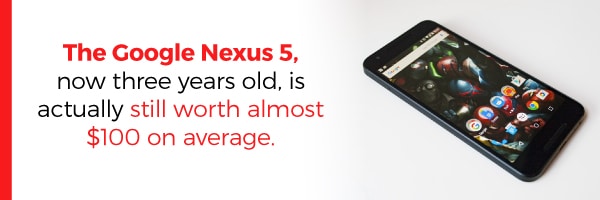
If you want to keep your phone model for over two years and tend to be more budget-conscious, a Google phone may be a good choice. Google phones haven’t reached Samsung or Apple in terms of popularity, but there’s no arguing that the phones are high quality.
The Google Nexus 5, now three years old, is actually still worth almost $100 on average. That’s 28 percent of its original $350 price tag. If Google continues to put out quality phones that retain their value as well as the Nexus 5, Google phones may end up being the phone of choice for people wanting two years or more out of their device.
Sony Phones
If you’re looking for something unique that’ll hold its value, you may want to consider Sony phones. The Sony Xperia Z Premium has enjoyed an unusually stable resale price in the United States, outperforming many similar phones. Most of this has to do with the limited availability of these phones, rather than the phones themselves.
BlackBerry Phones
BlackBerry phones are certainly intended for a specific audience, but if you’re still an avid user of this device, you should know that they follow similar depreciation patterns as other phones. The BlackBerry still holds some amount of popularity in certain demographics of the United States, primarily due to the presence of a physical keyboard on the device.
BlackBerry phones are also on the rarer side of the spectrum. The stable demand and limited availability has led to the phone holding up well compared to other models within the few months after release, but BlackBerry phones still drop rapidly in price after 6 months.
Got Something Different?
Off brand or particularly unique phones tend to lose value at a higher rate than brand-name devices. If you’re curious about a brand’s value retention, all you need to do is compare the current price of one of their devices to its original selling price, determine the percentage and compare it to how long the phone has been out. If the phone has hit 35 percent of its original value within six months of its release, the brand probably doesn’t retain value well. From that point on, it’s up to you whether you want to trade in as soon as possible to get the best resale price, or hold on to your phone and get your money’s worth out of it.
Finding the Best Buyer
If you’re trying to get rid of your old phone, The Whiz Cells can offer a great price and excellent service. As an electronics recycler, The Whiz Cells is dedicated to recycling and reusing electronics as long as possible, preventing unnecessary e-waste. We want to help reduce the waste going into landfills while helping people get their money’s worth out of their phones by reselling phones at reduced prices to people who need them.
You can trust us to give you a fair price for your phone. We cover all shipping costs, and we’ll even do a free phone data wipe to keep your information secure.
Put your old phone to good use — sell it to The Whiz Cells today!
